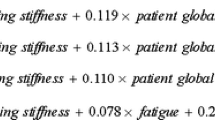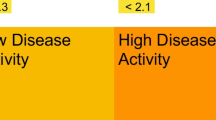Abstract
Routine Assessment of Patient Index Data 3 (RAPID3) is a composite index, very useful for assessment of disease activity of various rheumatic diseases including RA. If RAPID3 can also reliably measure disease activity in axial spondyloarthritis (axSpA), it may prove to be a practical and effective quantitative assessment tool in busy practices. We studied the association of RAPID3 with Bath Ankylosing Spondylitis Disease Activity Index (BASDAI). Patients with Ankylosing Spondylitis (AS) seen from 2007 to 2012 were classified as having AS or non-radiographic axial spondyloarthritis (nr-axSpA) using modified New York criteria and Assessment of SpondyloArthritis International Society criteria, respectively. Patients with simultaneous BASDAI and RAPID3 scores were enrolled (N = 112; 105 with AS, seven with nr-axSpA). Multiple regression and nonparametric receiver operating characteristics were used. Baseline mean (SD) BASDAI and RAPID3 were 4.2 (2.5) and 3.8 (2.3), respectively. Multiple linear regressions modeled a quadratic relationship between BASDAI and RAPID3 for 321 observations in 112 patients with axSpA (1) cross-sectionally: BASDAI predicted by RAPID3 (β = 1.171; s.e. = 0.113, p < 0.001) and RAPID32 (β = −0.037; s.e. = 0.014, p = 0.011) with an adjusted R 2 of 0.676; and (2) longitudinally: BASDAI predicted by RAPID3 (β = 1.196; s.e. = 0.111, p < 0.001), RAPID32 (β = −0.042; s.e. = 0.014, p = 0.004), and visit number (β = −0.142; s.e. = 0.038, p < 0.001) with an adjusted R 2 of 0.689. RAPID3 (correctly classified) corresponded to BASDAI scores of 2, 4, and 6: 1.40 (85.8 %), 3.33 (81.9 %), and 5.43 (87.1 %), respectively. RAPID3 correlates well with BASDAI in monitoring axSpA patients (including AS) in cross-sectional and longitudinal follow-up. Since it also correlates with measures of disease activity of other rheumatic diseases including RA, RAPID3 could be an attractive measure for assessing and monitoring disease activity of several conditions seen in busy rheumatology practices.



Similar content being viewed by others
References
Goekoop-Ruiterman YPM, Vries-Bouwstra JK, Allaart CF, van Zeben D, Kerstens PJSM, Hazes JMW et al (2007) Comparison of treatment strategies in early rheumatoid arthritis: a randomized trial. Ann Intern Med 146:406–415
Grigor C, Capell H, Stirling A, McMahon AD, Lock P, Vallance R et al (2004) Effect of a treatment strategy of tight control for rheumatoid arthritis (the TICORA study): a single-blind randomised controlled trial. Lancet 364:263–269
Puolakka K, Kautiainen H, Möttönen T, Hannonen P, Korpela M, Hakala M et al (2005) Early suppression of disease activity is essential for maintenance of work capacity in patients with recent-onset rheumatoid arthritis: five-year experience from the FIN-RACo trial. Arthritis Rheum 52:36–41
Boonen A, Chorus A, Miedema H, van der Heijde D, van der Tempel H, van der Linden SJ (2001) Employment, work disability, and work days lost in patients with ankylosing spondylitis: a cross sectional study of Dutch patients. Ann Rheum Dis 60:353–358
Smolen JS, Braun J, Dougados M, Emery P, FitzGerald O, Helliwell P et al (2014) Treating spondyloarthritis, including ankylosing spondylitis and psoriatic arthritis, to target: recommendations of an international task force. Ann Rheum Dis 73:6–16
Garrett S, Jenkinson T, Kennedy LG, Whitelock H, Gaisford P, Calin A (1994) A new approach to defining disease status in ankylosing spondylitis: the Bath Ankylosing Spondylitis Disease Activity Index. J Rheumatol 21:2286–2291
Zochling J (2011) Measures of symptoms and disease status in ankylosing spondylitis: Ankylosing Spondylitis Disease Activity Score (ASDAS), Ankylosing Spondylitis Quality of Life Scale (ASQoL), Bath Ankylosing Spondylitis Disease Activity Index (BASDAI), Bath Ankylosing Spondylitis Functional Index (BASFI), Bath Ankylosing Spondylitis Global Score (BAS-G), Bath Ankylosing Spondylitis Metrology Index (BASMI), Dougados Functional Index (DFI), and Health Assessment Questionnaire for the Spondylarthropathies (HAQ-S). Arthritis Care Res 63(Suppl 11):47–58
Pincus T, Yazici Y, Bergman M, Maclean R, Harrington T (2007) A proposed continuous quality improvement approach to assessment and management of patients with rheumatoid arthritis without formal joint counts, based on quantitative routine assessment of patient index data (RAPID) scores on a multidimensional health assessment questionnaire (MDHAQ). Best Pract Res Clin Rheumatol 21:789–804
Pincus T, Bergman MJ, Yazici Y, Hines P, Raghupathi K, Maclean R (2008) An index of only patient-reported outcome measures, routine assessment of patient index data 3 (RAPID3), in two abatacept clinical trials: similar results to disease activity score (DAS28) and other RAPID indices that include physician-reported measures. Rheumatology (Oxford) 47:345–349
Pincus T, Swearingen CJ, Bergman M, Yazici Y (2008) RAPID3 (Routine Assessment of Patient Index Data 3), a rheumatoid arthritis index without formal joint counts for routine care: proposed severity categories compared to disease activity score and clinical disease activity index categories. J Rheumatol 35:2136–2147
Castrejón I, Bergman MJ, Pincus T (2013) MDHAQ/RAPID3 to recognize improvement over 2 months in usual care of patients with osteoarthritis, systemic lupus erythematosus, spondyloarthropathy, and gout, as well as rheumatoid arthritis. J Clin Rheumatol 19:169–174
van der Linden SM, Valkenburg HA, Cats A (1984) Evaluation of diagnostic criteria for ankylosing spondylitis. Evaluation of diagnostic criteria for ankylosing spondylitis. A proposal for modification of the New York criteria. Arthritis Rheum 27:361–368
Rudwaleit M, van der Heijde D, Landewé R, Akkoc N, Brandt J, Chou CT et al (2011) The Assessment of SpondyloArthritis International Society classification criteria for peripheral spondyloarthritis and for spondyloarthritis in general. Ann Rheum Dis 70:25–31
Pincus T, Swearingen C, Wolfe F (1999) Toward a multidimensional Health Assessment Questionnaire (MDHAQ): assessment of advanced activities of daily living and psychological status in the patient-friendly health assessment questionnaire format. Arthritis Rheum 42:2220–2230
Pincus T, Sokka T, Kautiainen H (2005) Further development of a physical function scale on a multidimensional health assessment questionnaire for standard care of patients with rheumatic diseases. J Rheumatol 32:1432–1439
van der Heijde DMFM, Bellamy N, Calin A, Dougados M, Khan MA, van der Linden SJEF (1997) Preliminary core sets for endpoints in ankylosing spondylitis. Assessments in Ankylosing Spondylitis Working Group. J Rheumatol 24:2225–2229
Lukas C, Landewé R, Sieper J et al (2009) Development of an ASAS-endorsed disease activity score (ASDAS) in patients with ankylosing spondylitis. Ann Rheum Dis 68:18–24
van der Heijde D, Lie E, Kvien TK et al (2009) ASDAS, a highly discriminatory ASAS-endorsed disease activity score in patients with ankylosing spondylitis. Ann Rheum Dis 68:1811–1818
Pincus T, Swearingen CJ, Bergman MJ, Colglazier CL, Kaell AT, Kunath AM et al (2010) RAPID3 on an MDHAQ is correlated significantly with activity levels of DAS28 and CDAI, but scored in 5 versus more than 90 seconds. Arthritis Care Res 62:181–189
Pincus T, Strand V, Koch G, Amara I, Crawford B, Wolfe F et al (2003) An index of the three core data set patient questionnaire measures distinguishes efficacy of active treatment from that of placebo as effectively as the American College of Rheumatology 20 % response criteria (ACR20) or the Disease Activity Score (DAS) in a rheumatoid arthritis clinical trial. Arthritis Rheum 48:625–630
Pincus T, Chung C, Segurado OG, Amara I, Koch GG (2006) An index of patient reported outcomes (PRO-Index) discriminates effectively between active and control treatment in 4 clinical trials of adalimumab in rheumatoid arthritis. J Rheumatol 33:2146–2152
Pincus T, Furer V, Keystone E, Yazici Y, Bergman MJ, Luijtens K (2011) RAPID3 (Routine Assessment of Patient Index Data 3) severity categories and response criteria: similar results to DAS28 (Disease Activity Score) and CDAI (Clinical Disease Activity Index) in the RAPID 1 (Rheumatoid Arthritis Prevention of Structural Damage) clinical trial of certolizumab pegol. Arthritis Care Res 63:1142–1149
Kaptanoglu E, Sahin O, Durmaz Y, Cengiz AK, Hizmetli S (2013) Routine Assessment of Patient Index Data 3 in fibromyalgia: a rapid and reliable instrument for evaluating disease severity? Arthritis Rheum 65(Suppl 10):48
Source and grants
None
Disclosures
None
Author information
Authors and Affiliations
Corresponding author
Additional information
Final manuscript has been approved by all the authors and they confirm the integrity of the work.
Appendix (results for ankylosing spondylitis)
Appendix (results for ankylosing spondylitis)
The following figures present results for analyses of patients with ankylosing spondylitis paralleling those in the main text for patients with axial spondyloarthritis.
Correlation between BASDAI and RAPID3
Ankylosing spondylitis
Using multiple regression, we explained variation in BASDAI in terms of RAPID3 (β = 1.176; s.e. = 0.116, p < 0.001) and the square of RAPID3 (β = −0.038; s.e. = 0.015, p = 0.011) in a cross-sectional regression model, for 303 observations in 105 patients with an adjusted R 2 of 0.678. We regressed BASDAI onto RAPID3 (β = 1.213; s.e. = 0.114, p < 0.001) and the square of RAPID3 (β = −0.044; s.e. = 0.015, p = 0.003) while controlling for visit number (β = −0.156; s.e. = 0.042, p < 0.001), for observations and patient with an adjusted R 2 of 0.691. These results are presented in Table 4 and in Fig. 4.
A nonparametric smoothing regression (black line; 95 % confidence band, thin dashed lines) suggested a quadratic relationship between BASDAI and RAPID3 for patients with ankylosing spondylitis, so a multiple least squares regression model of BASDAI as a quadratic function of RAPID3 and a linear function of period was fit (blue line). The same model was fit while accounting for within-patient clustering of observations and produced nearly identical results (red line)
Correlation between BASDAI and RAPID3 longitudinally over visits
Individual BASDAI scores (light blue) and RAPID3 scores (pink) are plotted over the order of patient visits for patients with ankylosing spondylitis. Linear regression estimates for BASDAI over time (blue line) and RAPID3 over time (red line), along with nonparametric estimates of trend for BASDAI (blue dots) and RAPID3 (red dots), are overlaid. Both sets of estimates agree closely, with divergence only for very high visit numbers (i.e., sparse data)
Correlation among the individual items of BASDAI and RAPID 3
Cutoff scores by nonparametric ROC curves
Rights and permissions
About this article
Cite this article
Danve, A., Reddy, A., Vakil-Gilani, K. et al. Routine Assessment of Patient Index Data 3 score (RAPID3) correlates well with Bath Ankylosing Spondylitis Disease Activity index (BASDAI) in the assessment of disease activity and monitoring progression of axial spondyloarthritis. Clin Rheumatol 34, 117–124 (2015). https://doi.org/10.1007/s10067-014-2827-4
Received:
Accepted:
Published:
Issue Date:
DOI: https://doi.org/10.1007/s10067-014-2827-4







